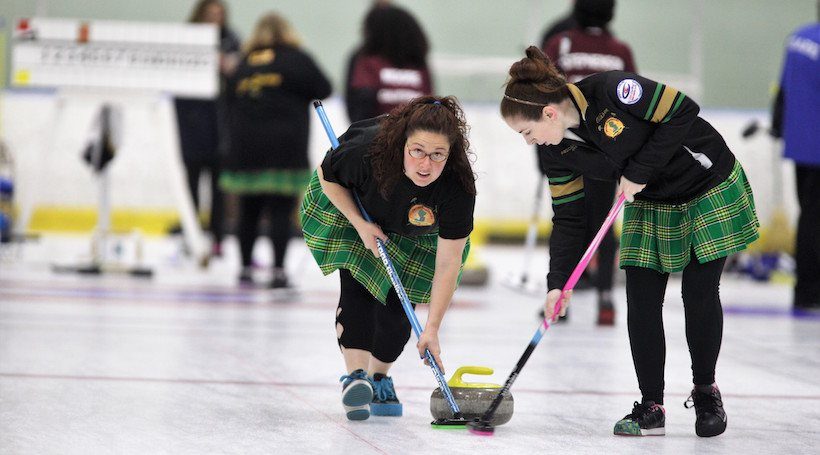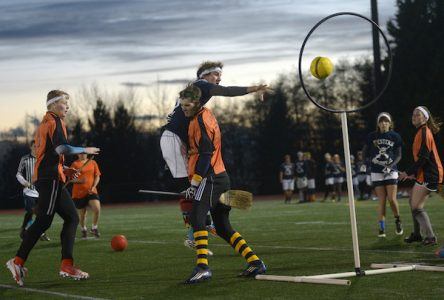There’s no shortage of athletics in South Jersey, but some players definitely walk a little on the wild side when choosing their sport. Take a look at these unusual games with their own unique vocabularies, rules and players. But there’s one thing that hasn’t changed: it’s still all about having fun.
Curling: Chess on ice
Bridget O’Grady has been on the ice since she was 4 years old, from figure skating to working at an ice rink. But she’s never seen anything quite like the sport of curling.
“You meet people from all walks of life,” says O’Grady, one of the original members of the Jersey Pineland Curling Club, which was created in 2014 and practices at The Igloo in Mount Laurel.
The game is played on ice, and players, called curlers, guide stones toward a target area. The target is segmented into four circles, almost like a bullseye – the closer to the inside of the circle the players get the stones, the higher the points scored.
Each team has eight stones, which are also called rocks. Curlers don’t touch the rocks, but use a broom to sweep the ice surface in front of the stone to keep it moving and direct its path. The team captain, called the skip, plots the best path for the stones to maximize the possible number of goals. Curling is often nicknamed chess on ice because the game is more about strategy and planning than athletic ability, O’Grady says.
“To start off, you really only need sneakers and warm clothing,” O’Grady says. “Everything else is provided by the club. Well, you need enthusiasm, too.”
Most players start with regular athletic sneakers and use step-on sliders or grippers, which provide traction on the ice.
“Once you have balance on the ice down, the concept is relatively easy and the game is a lot of fun,” O’Grady says. “The people are what keep you coming back.”
After a competition, called a bonspiel, teams hold an event called broomstacking.
“It’s where you hang out with the team you played against and have snacks and something to drink,” O’Grady says. “We’re enemies on the ice, but once we’re off the ice, we’re definitely friendly.”
Curling has been around since late medieval times and was originally played in Scotland. It became an official Olympic Sport in 1998 and is played around the world.
O’Grady has also enjoyed the ability to travel thanks to curling. She visited Cape Cod one year with a few other women from the team and even played against the current US Women’s Curling Association president – which was a little intimidating, O’Grady laughs, but also a great experience.
“I had only been curling for about two years, so that was insane,” she says. “Off the ice, they were so helpful and gave us tips of what to work on. Everybody, regardless of how long they’ve been playing, is so positive.”
O’Grady admits that not a lot of people know there’s curling available in South Jersey area – there’s only about 60 people in the Jersey Pinelands Curling Club – but she’s hoping to change that.
“Once they hear about it,” she adds, “they get really excited.”
 Pickleball: A little bit of tennis, a dash of racquetball and a pinch of ping pong
Pickleball: A little bit of tennis, a dash of racquetball and a pinch of ping pong
When Denise Donald tried out pickleball for the first time in 2011, she had no idea how much the sport would change her life.
“I got hooked,” says Donald, who lives in Cherry Hill.
Hooked is putting it mildly. Today, Donald is the South Jersey ambassador for the USA Pickleball Association and helps oversee multiple pickleball meet-ups in the region, as well as organizing tournaments and teaching newcomers. Donald became addicted to the sport, as she puts it, for the same reasons there’s a growing number of players across the country.
Pickleball is played on a court a little smaller than a tennis court. The net is set lower than it would be for a tennis match and players use a wiffleball instead of a tennis ball. Their racquets are different, too – it’s more like an oversized ping pong paddle than anything else.
“It’s easy, it’s fun and you get to laugh, meet new people and be outside in the sunshine,” Donald says. “You’re getting a full-body exercise, but it’s accessible for everybody. We have a gentleman in a wheelchair who plays with us on Wednesday nights.”
The game is played with two people on each side of the net. One person begins the game by serving – always underhand – and sending the ball diagonally into the other court. The ball must bounce once before the other team returns it, and then the two teams volley until the server scores a point. Once a point is scored, all four players will shuffle through playing as server. Points are scored when the other team fails to return the ball or when they hit it out of bounds.
Pickleball has quickly become popular, particularly with older individuals who might find other sports too physically rigorous. Donald herself has had a hip replacement and arthritis in her feet, but she never has trouble playing the sport. She has quite a few players in their 70s too, and, thanks to Donald, they learned a lot more than just a new sport.
“They started a book club and they all hang out together,” she says. “They’ve got a whole new life and things to do because of pickleball.”
At its roots, pickleball is a social sport. The shuffling of players on the court makes sure players meet new people, and Donald ensures that the first hour or so of a meet-up mixes skill levels, too. She likes seeing advanced players offer some tips to beginners and hopes everyone walks away meeting a new friend.
The social aspect is a big part of why pickleball has grown so tremendously, Donald says – something she’s seen with her own eyes. Ten years ago, Donald started playing with about 10 people. Now there’s more than 300 players in the online groups Donald uses to organize game times.
“There’s about 3 million people playing in the country right now,” Donald adds. “We’re expecting it to hit 8 million by 2018.”
In fact, Donald can hardly find enough places for her players to get some game time – they play at Cherry Hill Racquet Club, the Kroc Center, the Church Street Recreation Center, the Gloucester Township Recreation Center and the Blue Barn, and it’s hardly enough to satisfy everyone who wants to come out and play some pickleball, she says.
Balls and nets are provided, too, so interested players need only bring a few bucks – each location varies for cost to play – and a paddle, which costs between $50 and $100.
“It’s addictive, though,” Donald warns. “Before you know it, you’ll be wanting to play twice a day, five days a week.”
 Quidditch: Making magic come to life
Quidditch: Making magic come to life
When the final installment of the Harry Potter movie series premiered, it felt like there wasn’t a whole lot of magic left for fans. But then some Potter lovers found a way to live in that supernatural universe a little bit longer by bringing quidditch – a competitive sport in the novels – right here to the muggle world.
But with a few adjustments, of course.
“When I found out it was a real sport, I thought it sounded so cool,” says Matt Tozzi, a Hamilton resident and founder/captain of The-Team-Who-Must-Not-Be-Named. “I kind of forced my friends to play and then did a mini-fundraiser to try and start a team.”
That team is now 12 members strong after its founding last summer. To play, teams need a minimum of seven players. The co-ed, contact sport mixes elements of rugby, dodgeball and tag – and of course, players run around the field with a broom between their legs to emulate the flying broomsticks made so famous by the Harry Potter films.
There are four different positions – seeker, chasers, beaters and keeper – and three different “balls” in play. One is the snitch, or the winged, golden ball that zooms around the quidditch field in the movies. In the human world, the snitch becomes a runner dressed in yellow with a tail that the seeker must snatch. A quaffle, or volleyball, is used to score points when players kick it into hoops. Bludgers, or dodgeballs, are used to set back other players. If someone is hit with a bludger, they must drop any ball they are holding, return to their side of the field and touch one of their goalposts before re-entering play.
“It’s kind of complicated to see it on paper or hear how it’s played,” Tozzi admits. “There’s definitely a learning curve with the fundamentals of the game, but the more you play, the easier it gets.”
Running with a broom between your legs sounds like one of the biggest adjustments to giving quidditch a go, but Tozzi insists it’s not too difficult. “You would be surprised by how quickly you’ll learn to let go of the broom and still be able to run,” he says.
But quidditch is definitely a workout, Tozzi stresses. Realizing how much cardio the game required was a “rude awakening” for him. “In the first few minutes of the first couple times I played, I was dead,” Tozzi laughs. “You definitely need to get your cardio up to play.”
To join one of the 300 or more teams around the world, you’ll need a broom, a mouth guard and a $50 registration fee. If you’d like to play with a team but not compete, most groups will allow interested individuals to join them at practice.
For Tozzi, it’s a small price to pay for the feeling quidditch creates.
“You kind of feel like you’re immersed in the Harry Potter universe in a way,” he says. “You can’t do magic, obviously, but it really gives you that magical feeling.”



 Pickleball: A little bit of tennis, a dash of racquetball and a pinch of ping pong
Pickleball: A little bit of tennis, a dash of racquetball and a pinch of ping pong Quidditch: Making magic come to life
Quidditch: Making magic come to life










